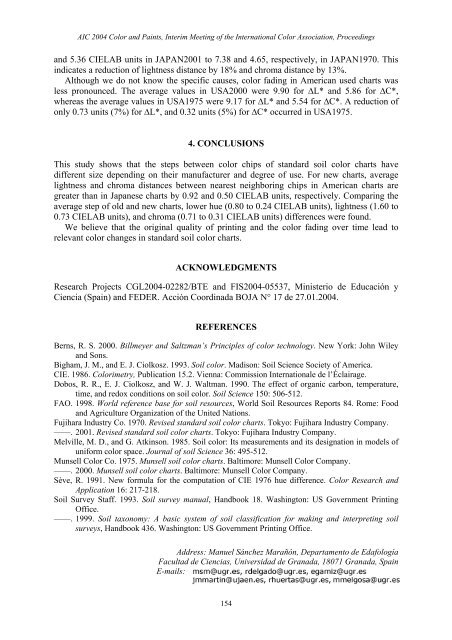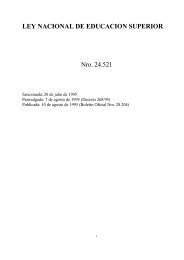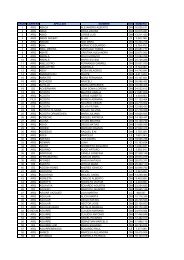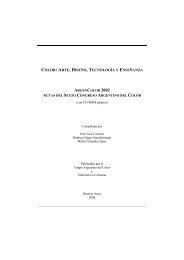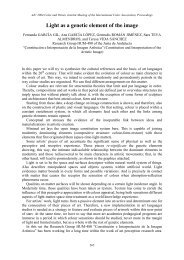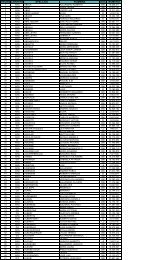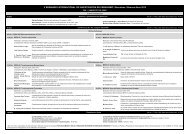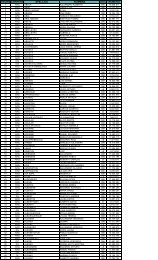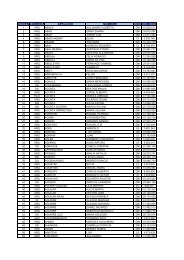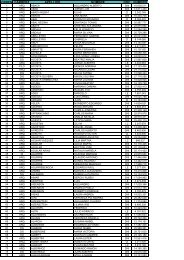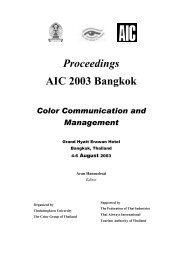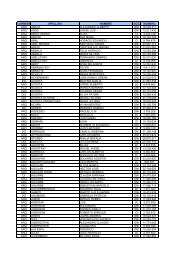Four soil color charts compared in CIELAB color space
Four soil color charts compared in CIELAB color space
Four soil color charts compared in CIELAB color space
Create successful ePaper yourself
Turn your PDF publications into a flip-book with our unique Google optimized e-Paper software.
AIC 2004 Color and Pa<strong>in</strong>ts, Interim Meet<strong>in</strong>g of the International Color Association, Proceed<strong>in</strong>gsand 5.36 <strong>CIELAB</strong> units <strong>in</strong> JAPAN2001 to 7.38 and 4.65, respectively, <strong>in</strong> JAPAN1970. This<strong>in</strong>dicates a reduction of lightness distance by 18% and chroma distance by 13%.Although we do not know the specific causes, <strong>color</strong> fad<strong>in</strong>g <strong>in</strong> American used <strong>charts</strong> wasless pronounced. The average values <strong>in</strong> USA2000 were 9.90 for ∆L* and 5.86 for ∆C*,whereas the average values <strong>in</strong> USA1975 were 9.17 for ∆L* and 5.54 for ∆C*. A reduction ofonly 0.73 units (7%) for ∆L*, and 0.32 units (5%) for ∆C* occurred <strong>in</strong> USA1975.4. CONCLUSIONSThis study shows that the steps between <strong>color</strong> chips of standard <strong>soil</strong> <strong>color</strong> <strong>charts</strong> havedifferent size depend<strong>in</strong>g on their manufacturer and degree of use. For new <strong>charts</strong>, averagelightness and chroma distances between nearest neighbor<strong>in</strong>g chips <strong>in</strong> American <strong>charts</strong> aregreater than <strong>in</strong> Japanese <strong>charts</strong> by 0.92 and 0.50 <strong>CIELAB</strong> units, respectively. Compar<strong>in</strong>g theaverage step of old and new <strong>charts</strong>, lower hue (0.80 to 0.24 <strong>CIELAB</strong> units), lightness (1.60 to0.73 <strong>CIELAB</strong> units), and chroma (0.71 to 0.31 <strong>CIELAB</strong> units) differences were found.We believe that the orig<strong>in</strong>al quality of pr<strong>in</strong>t<strong>in</strong>g and the <strong>color</strong> fad<strong>in</strong>g over time lead torelevant <strong>color</strong> changes <strong>in</strong> standard <strong>soil</strong> <strong>color</strong> <strong>charts</strong>.ACKNOWLEDGMENTSResearch Projects CGL2004-02282/BTE and FIS2004-05537, M<strong>in</strong>isterio de Educación yCiencia (Spa<strong>in</strong>) and FEDER. Acción Coord<strong>in</strong>ada BOJA N° 17 de 27.01.2004.REFERENCESBerns, R. S. 2000. Billmeyer and Saltzman’s Pr<strong>in</strong>ciples of <strong>color</strong> technology. New York: John Wileyand Sons.Bigham, J. M., and E. J. Ciolkosz. 1993. Soil <strong>color</strong>. Madison: Soil Science Society of America.CIE. 1986. Colorimetry, Publication 15.2. Vienna: Commission Internationale de l’Éclairage.Dobos, R. R., E. J. Ciolkosz, and W. J. Waltman. 1990. The effect of organic carbon, temperature,time, and redox conditions on <strong>soil</strong> <strong>color</strong>. Soil Science 150: 506-512.FAO. 1998. World reference base for <strong>soil</strong> resources, World Soil Resources Reports 84. Rome: Foodand Agriculture Organization of the United Nations.Fujihara Industry Co. 1970. Revised standard <strong>soil</strong> <strong>color</strong> <strong>charts</strong>. Tokyo: Fujihara Industry Company.——. 2001. Revised standard <strong>soil</strong> <strong>color</strong> <strong>charts</strong>. Tokyo: Fujihara Industry Company.Melville, M. D., and G. Atk<strong>in</strong>son. 1985. Soil <strong>color</strong>: Its measurements and its designation <strong>in</strong> models ofuniform <strong>color</strong> <strong>space</strong>. Journal of <strong>soil</strong> Science 36: 495-512.Munsell Color Co. 1975. Munsell <strong>soil</strong> <strong>color</strong> <strong>charts</strong>. Baltimore: Munsell Color Company.——. 2000. Munsell <strong>soil</strong> <strong>color</strong> <strong>charts</strong>. Baltimore: Munsell Color Company.Sève, R. 1991. New formula for the computation of CIE 1976 hue difference. Color Research andApplication 16: 217-218.Soil Survey Staff. 1993. Soil survey manual, Handbook 18. Wash<strong>in</strong>gton: US Government Pr<strong>in</strong>t<strong>in</strong>gOffice.——. 1999. Soil taxonomy: A basic system of <strong>soil</strong> classification for mak<strong>in</strong>g and <strong>in</strong>terpret<strong>in</strong>g <strong>soil</strong>surveys, Handbook 436. Wash<strong>in</strong>gton: US Government Pr<strong>in</strong>t<strong>in</strong>g Office.Address: Manuel Sánchez Marañón, Departamento de EdafologíaFacultad de Ciencias, Universidad de Granada, 18071 Granada, Spa<strong>in</strong>E-mails:154


